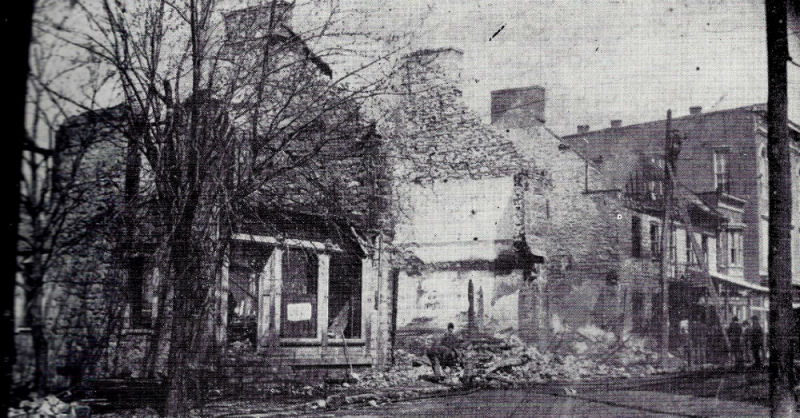
The 1901 Hartley Bank Fire
Fire altered the appearance of a part of Bedford Borough on Friday, 29 March 1901 with the destruction of a number of very old buildings on Pitt Street. Like the change in appearance that resulted from the 1885 fire in the buildings on the southeast corner of the intersection of Juliana and Pitt Streets, the loss of the buildings on the northeast corner of the same intersection forever changed the look of Bedford.
The so-called Hartley Bank Fire destroyed the bank on the corner and the Blymyer Hardware Store to the east in addition to the Bouquet House (i.e. the stone dwelling of Christopher Lems), still farther to the east. Photos taken just days after the fire show the three-storey Italianate building at 115 East Pitt Street (currently occupied by S&S Appliance) still standing along with a narrow structure just to the west of it and beside the destroyed Bouquet House. The fire that completely gutted the bank, the hardware store and the Bouquet House was believed to have started in the photography studio of W. A. Morehouse in the Blymyer building.
The conflagration has come to be known as the Hartley Bank Fire and was described in the Bedford Gazette in the issue following the fire. At 3 o’clock on the morning of Friday, 29 March 1901 a fire started in a room of the Blymyer building which was being leased by W. A. Morehouse, a photographer. The owners of the building, Mr. and Mrs. John F. Blymyer, who resided in a portion of the building, were aroused by the smoke and immediately sounded the alarm. A group of residents gathered in the street and began a bucket brigade. Initially the townsfolk argued about whether breaking down the door of the photographer’s room would help or hinder the effort to subdue the fire. The door was finally broken in and a few buckets of water did indeed quench the fire. But before anyone could prevent it, the fire kindled again. In the meantime, the fire company arrived and hooked their lines up to plug at the corner of Pitt and Juliana Streets. Unfortunately, the water stream from the plug was very poor. In an attempt to get it to send forth a stronger stream, the plug’s stem was twisted too far and broke, putting the plug entirely out of service. Hose was attached to two other plugs in the vicinity, but there simply was not enough force to be effective. The March winds fanned the flames, spreading sparks over adjacent buildings, and even across Pitt Street, threatening a repeat of the 1885 fire in the Rising Sun Tavern. Memories of that fire, being only fifteen years old, were probably fresh in the firemen. The pump at the planing mill was fired up and boosted the stream of which the firemen took advantage. They, according to the newspaper article: “saved all the imperilled buildings except those already doomed before the pump started.” By the time the fire was brought under control, gone were the Blymyer Hardware store, the Morehouse photography gallery, the office of the Singer Sewing Machine company and the residence of the J. F. Blymyer family in the Blymyer building; the Hartley & Company’s banking house; a number of smaller businesses located in the Bouquet House, then known as the Adam B. Carn building: J. Scott Corle’s novelty store, Oliver S. Defibaugh’s cigar store and the residence of the Samuel S. Gump family; and Amos C. Daniel’s dentist office and Charles W. Nagler’s barbershop in the partially damaged J. W. Ridenour building. The metal roofs on the buildings along the south side of Pitt Street helped to prevent them from catching fire from the blowing sparks, but most of their plate glass windows were broken from the heat, and some of the woodwork inside those buildings were damaged.
A saving grace for some of the people affected was that the fire didn’t move quickly. Some of those people affected were able to remove at least a portion of their equipment and supplies and personal effects to safety. Mr. Daniels was able to save most of his furniture and equipment and moved his dentist office into the Barnett Building. Mr. Nagler moved into the basement of the Ridenour Block.
Mr. Carn and Mr. Blymyer initially offered their properties for sale, with Mr. Blymyer announcing that if not sold, he planned to rebuild on the site. An announcement was placed by the Blymyer Hardware store in the Bedford Gazette in the Friday April 5, 1901 issue. The ad stated that “The Blymyer Hardware Co., will resume business in the Oppenheimer building about April 15, where they will be glad to see their old friends and customers.” The Oppenheimer Building was located on the southeast corner of the intersection of Pitt and Richard Streets. Mr. Blymyer did not keep his hardware store in the Oppenheimer Building for long. By the winter of 1901, John F. Blymyer, owner of the hardware store, got a new building rebuilt on the site of the fire. J. Scott Corle, one of the tenants of Blymer’s previous building, placed an advertisement in the December 6 issue of the Gazette. It stated “Next Monday I shall move into my new store in the Blymyer Building, where I shall be glad to have my patrons call and inspect my fine display of Holiday Goods.” The new Blymyer Building was, like others of this time period, built in the Italianate style. It stands today at 107-111-113 East Pitt Street and is currently occupied by the Briar Valley Vinyards & Winery, the Cove Creek Outfitters and, until recently, GiGi’s Store. As of this writing (July 2020), the storefront at 113 E. Pitt Street, previously occupied by GiGi’s is vacant.
Within a few hours of the fire, on Friday morning, the Hartley Bank was opened for business within the Tate Building on the southeast corner of Juliana Street and Central Way (currently occupied by the Penn Square Centre). The Hartley Bank was rebuilt during the following year, 1902, in the then-current Queen Anne architectural style, a variation of Victorian. The new stone edifice’s Pitt Street façade was narrow, with only a narrow door and slightly wider than normal window on the ground level, mimicked by windows on the second floor. The Juliana Street side was longer and accommodated six bays. In the Queen Anne style, popular between 1880 and 1910, the building sported a very steep hip roof with dormers. Also in characteristic style, the building had a turret rising on the southwest corner, surmounted by a bell shaped cupola. The main entrance, recessed in the corner turret and positioned at 45 degree angles to both walls, was flanked by round columns supporting a balcony/mantle in place of a roof. Unfortunately, the beautiful structure was torn down in the 1980s.
The photo below shows the north side of Pitt Street that sustained the fire damage.

The photo below highlights the Christopher Lems House that was commonly known as the Bouquet House because Colonel Henry Bouquet often stayed there when he visited after continuing the construction of Forbes Road westward. The tallest building shown in this photo standing to the right (east side) of the Lems/Bouquet House is still standing and is currently occupied by S&S Appliance. The site of the Lems/Bouquet House and the two-story building standing immediately to the right (east side) of it currently is occupied by the 'new' Blymyer Building with its primary tenant, the Cove Creek Outfitters.






